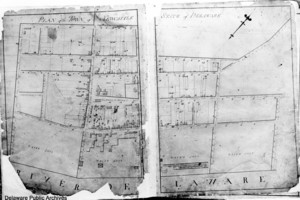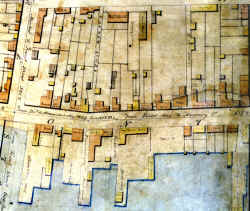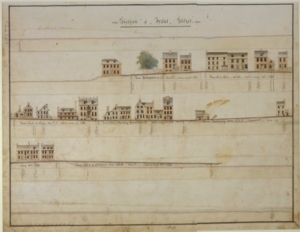-
Census information varies among the
various decennial censuses. None before 1900 give the street number--
you have to know the resident's name. But you can find out who lived
in a house, occupation, literacy...
You can search the entire Heritage
Quest database of all states from 1800 on if you have a public library card
in one of the Delaware Counties. For 1850 and 1870 all the New Castle
records have been transcribed, and are available as text or as spreadsheet/database,
with analysis by family size, wealth, birthplace,
race, birthplace...
-
Wills reveal not only property bequests,
but provides information on spouses, parents and children, and sometimes
even long-term employees or friends.
-
Probate Records can provide insight not
only about possessions and their valuation but also what rooms were used for
and where the possessions were located. [dungan link]
-
Orphans court has information about
properties of homeowners who die leaving minor children. The records
from 1770 - 1830 have been abstracted. Those for New Castle town and
hundred are available here. You must know the name of the
deceased to find a record, but just browsing is fun. For
example, the Dutch tile house on the Strand was described as:
YEATES, JOHN (child-Ann) I-1-448 (1806) New Castle Hundred,
Town of New Castle - lot on Front Street
...an old House in bad repaire a Stable and Carriage House a Well which wants to be cleaned out and a Pump
placed therein the Floors in the House to be laid with good Hart-pine boards and new stairs made the South East
Gable and being so bad deem it for the benefit of the Orphans that it should be taken down to the Ground and rebuilt
the rooff to be made as far as the Chimney to corospond with Doctr. James McCallmont's and to be pitch to Front
Street the ally to be paved with Stone to carry the Water in the Midle thereof to the Street gutter the Windows being
in bad repaire we deem it advisable to have them put in good order new Joice to be put in where the decayed ones is
the plaistering of the Walls being broken and decayed is to be plaistered where necessary...
annual value $120.00
-
Tax records available from CHAD at U. D.
list the person, and his or her real property and their value. For example
in 1816 this includes house and land, acreage, rental property, plate
(silver only? also gold?) and slaves for life (or for e.g. 7 years), their
names and value. Charles Thomas in 1816 owned a store rented to
McCullough, 2 rental house and 5 slaves for life of various
ages.
example
in 1816 this includes house and land, acreage, rental property, plate
(silver only? also gold?) and slaves for life (or for e.g. 7 years), their
names and value. Charles Thomas in 1816 owned a store rented to
McCullough, 2 rental house and 5 slaves for life of various
ages.
-
Newspaper accounts. The Philadelphia
Gazette (the 'New York Times of the 18th century') has been indexed
by Accessible
Archives from 1754-1800. Search on early occupants can be
interesting. For example, Slator Clay who ran a store at 30 The Strand
was reported as selling an almost new sloop. J
M'Cullough had for sale 2 stills at J M'Cullough near New Castle in 1813 or
J & E M'Cullough in New Castle (according to an ad
in The American Watchman).
-
Graves -- Most early inhabitants were
buried in the Episcopal  churchyard or in the Presbyterian cemetery near
Brosius Eliason lumber yard. The graves can help establish birth/death dates which
may useful as a starting point for search of newspapers without
indices.
churchyard or in the Presbyterian cemetery near
Brosius Eliason lumber yard. The graves can help establish birth/death dates which
may useful as a starting point for search of newspapers without
indices.
-
The accumulated biographical
information [under construction] from the above sources gives a very
sketchy idea of the previous owners and their lives. What was life
like for them-- interiors/exteriors of their houses, food, social
interactions, drinking, sex, possessions, education, taxes, wealth,
occupation, travel.... Although snippets of information can be gained
from deeds, census, wills, probate records, a better picture can be gained
through [under construction!!!] economic,
historic and material
culture studies of colonial and post-revolutionary America.
 but there are some resources specific to the Town of New Castle.
These research approaches are listed below in order of ease
of use and usefulness. Even if you know only the address of a property in the
historic area you can
find out the names of occupants or owners from the first settlement in the
1650's up to the 1840's. These names
help with the other approaches such as census, probate, tax or burial records.
but there are some resources specific to the Town of New Castle.
These research approaches are listed below in order of ease
of use and usefulness. Even if you know only the address of a property in the
historic area you can
find out the names of occupants or owners from the first settlement in the
1650's up to the 1840's. These names
help with the other approaches such as census, probate, tax or burial records.  Researching Your House in the Town of New Castle
Researching Your House in the Town of New Castle








